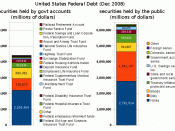US Dollar Domination Has To Go
There is an economics-textbook myth that foreign-exchange rates are determined by supply and demand based on market fundamentals. Economics tends to dismiss socio-political factors that shape market fundamentals that affect supply and demand. The current international finance architecture is based on the United States' dollar as the dominant reserve currency. According to the Bureau of Public Debt "it accounts for 68 percent of global currency reserves, up from 51 percent a decade ago. Yet in 2000, the US share of global exports (US $781.1 billon out of a world total of $6.2 trillion) was only 12.3 percent and its share of global imports ($1.257 trillion out of a world total of $6.65 trillion) was 18.9 percent. World merchandise exports per capita amounted to $1,094 in 2000, while 30 percent of the world's population lived on less than $1 a day, about one-third of per capita export value" (Bureau of Public Debt Online).
Ever since 1971 when president Richard Nixon took the dollar off the gold standard, the dollar has been a global monetary tool that the United States, and only the United States, can produce by fiat. The dollar is now a fiat currency. A flit currency is defined as a type of currency whose only value is that a government made a decreed that the money is a legal method of exchange (Wikipedia). The dollar is at a sixteen-year trade weighted high despite record US current-account deficits and the status of the US as the leading debtor nation. The United States national debt as of August 29, 2003 was $6.783 trillion against a gross domestic product of $9 trillion (Bureau of Public Debt).
World trade is now a game in which the US produces dollars and the rest of the world produces things...


